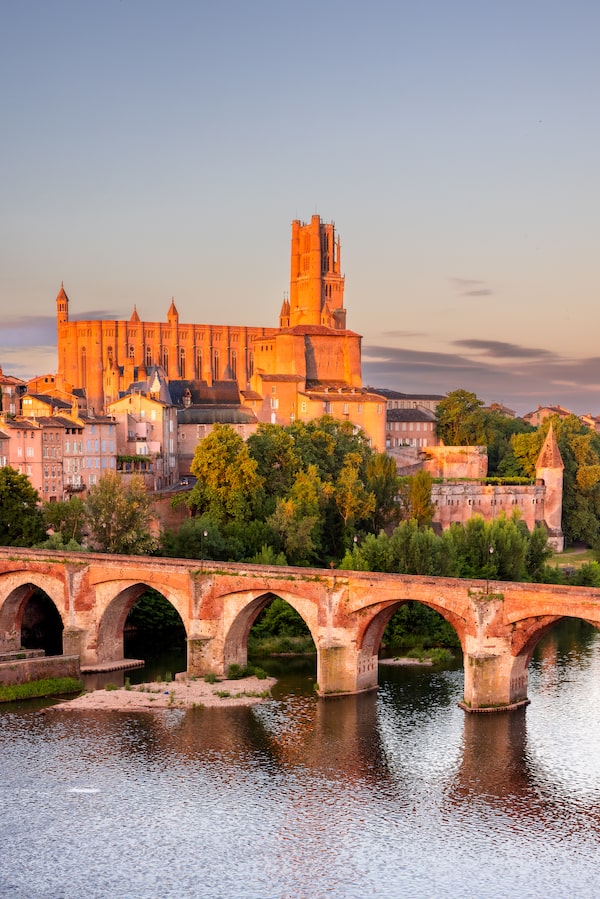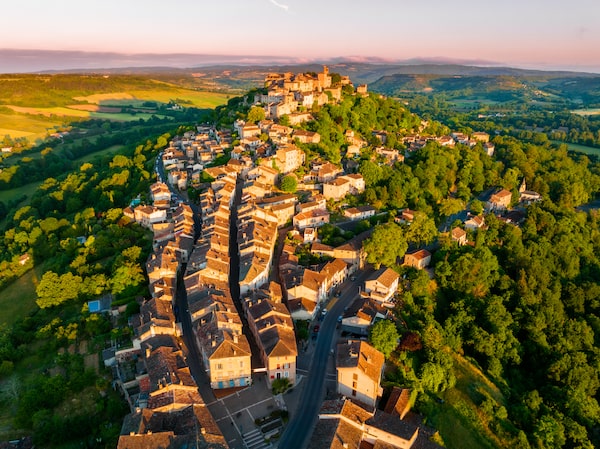If you enter a bakery in the French towns of Toulouse, Albi or Montauban, and ask for that popular pastry known as a “pain au chocolat,” you will be sharply corrected. Here in Occitanie, the region covering the central section of southern France, that is a chocolatine. The linguistic difference can possibly be traced back to the Occitan word for the pastry, chocolatina, and has become something of a marketable joke: In the souvenir shops, you can buy trays and shopping bags explaining “Ici, c’est chocolatine.”
The word is just one small example of the way France’s southerners, known through history as dissenters and rebels, hold fast to cultural differences. Foreigners flock to Provence; sunseekers bask on the beaches of the Côte d’Azur; but just next door in Occitanie, there are charming low-key towns where a history of southern rebellion has given way to a gentler life filled with good food, vibrant culture and fierce local pride. The region’s most famous site is probably the medieval walled city of Carcassonne; Occitanie also offers Mediterranean beaches on its east coast and ski resorts in the Pyrenees near its border with Spain, but off the beaten path in its interior you can stroll through distinctive red-brick towns nestled on the banks of the Tarn and Garonne rivers, or bike along the bucolic Canal du Midi.
The merger of two smaller departments to create Occitanie in 2014 was intended to extend the economic benefits of seasonal tourism and year-round industry, based especially in Toulouse. When citizens were consulted as to what name they wanted, they picked Occitanie, the old name for southern France. Its language, Occitan or Languedoc, has all but died out, yet people will boast their grandparents spoke it and attempts at revival include a bilingual school in Toulouse. Folks are friendly and firm: You aren’t in Paris any more. The Tricolore may flutter on every city hall in the region, but it’s often joined by the red-and-yellow flag showing the Occitan cross.
Fortress Albi

The town of Albi in the south of France with the Cathédrale Sainte-Cécile in the background.Loic Lagarde/Handout
Set on a high bank of the Tarn river, today’s Albi is a lively red-brick city with a historic core of narrow streets filled with half-timbered houses and boutiques selling local products. In the 12th century, however, Albi was a hotbed of wild new ideas propagated by a sect known as the Cathars. They were Christian dualists who believed in two gods, one good with whom they would be reunited after death, the other evil and ruling over the physical world. Their beliefs seemed to contradict monotheism and Pope Innocent III would have none of it. In 1209, he ordered a military campaign against the Cathars, murdering many believers and re-establishing Catholic doctrine by force.
The imposing Cathédrale Sainte-Cécile in the town’s central square looks more like a fortress than a house of worship: The intimidating architecture was a symbol of the material power of the Church. Inside, it is stuffed with delicate stone statuary and covered in colourful frescoes, including an altar wall depicting the Last Judgement in gruesome detail. One tour guide compares the cathedral, forbidding on the outside, all decorated on the inside, to a Kinder Surprise, the chocolate egg that hides a toy inside.
Next door, the impressive bishop’s palace was also fortified, as the local bishops established themselves as the temporal authority, too. The Palais de la Berbie, as it is known, is gradually being restored and houses the Toulouse-Lautrec Museum with an interesting collection of paintings by the 19th-century artist Henri de Toulouse-Lautrec, famed for his posters advertising the Moulin Rouge and the Cabaret Aristide Bruant.
The artist was a son of Albi – you can see the house where he was born not far from the cathedral – and also something of a rebel. His father’s family were descendants of the counts of Toulouse who once ruled the area, but he hightailed it to the fleshpots of Paris at the age of 18. The museum includes a room dedicated to his sympathetic paintings of brothels and the women who worked there.
Hilltop Cordes-sur-Ciel

The picturesque hilltop town of Cordes-sur-Ciel, 25 kilometres northwest of Albi.Loic Lagarde
There’s another fascinating example of a far subtler form of artistic dissent in the picturesque hilltop town of Cordes-sur-Ciel, 25 kilometres northwest of Albi. Cordes was a medieval bastide – planned towns that were often fortified – and is now a busy local attraction. (It is largely unknown to foreign visitors but popular with the French who voted it their favourite village in a TV series in 2014.) Cars park at the bottom of the hill and tourists either climb the narrow streets themselves or ride a motorized train halfway up.
One of the grandest houses is known as the Huntsman’s House because of the statuary on its 14th-century facade showing dogs chasing a boar. Perhaps it’s a cheery scene evoking how a wealthy merchant liked to spend his spare time, but there may be hidden Cathar symbolism. The Dominican friars were the domini canes, the Lord’s dogs, assigned with persecuting the Cathars, who are represented here by the boar of the true religion.
Rosy Montauban
The Cathars had been suppressed by the end of the 13th century but 200 years later the Protestants rose up to challenge the Church. Nearby Montauban, another brick city and perhaps the pinkest of the so-called villes roses, was a Protestant stronghold in the 16th century where the new religion was tolerated by Comte de Toulouse. Again the Church re-established its authority in the late 17th century, and the Protestants were horribly persecuted. Just like the imposing cathedral of Albi, the massive stone Cathédrale Notre-Dame de l’Assomption sent a strong message to dissenters. Montauban’s 17th-century cathedral, made in rare white stone imported to a brick city at great expense, insisted on the importance of what was now the Roman Catholic Church.
Today, Protestants make up a third of the town’s congregants and, while the cathedral is closed for renovations, the major attraction is the lavishly restored bishop’s palace, now the Musée Ingres-Bourdelle. It is a testament to museology, making the most of what is a minor collection of paintings by the mid-19th-century French painter Jean-Auguste-Dominique Ingres, the town’s most famous son. His famed Grande Odalisque and many portraits of the Napoleonic bourgeoisie are in Paris at the Louvre, but for the student of French art, Montauban has most of his drawings, cleverly hidden from the light in wood sleeves that can be pulled out to view. The drawings are central to his work: The meticulous Ingres, known for capturing a lace collar or fur cuff with the same intense precision he devoted to his sitters’ alabaster skin, made dozens of preparatory drawings for every painting.
Toulouse, Albi and Montauban are all gorgeously restored. Montauban’s Place Nationale, a striking square with a double arcade built in the 17th century, has a clever new miroir d’eau, part public fountain, part splash pad where kids can play and adults can appreciate a misting effect on a hot summer day. And, in front of the cathedral, the Place Franklin Roosevelt has just reopened with a new garden of local plants replacing a parking lot. The centre of the city is largely pedestrianized, as are the historic cores of Albi and Toulouse.
Are these special places the result of southern pride or the power of Paris and its centralized taxation? Probably a bit of both but as you wander these picturesque streets, you can contemplate the violent disputes of earlier centuries in perfect tranquility.
If you go
Montauban, perhaps the pinkest of the so-called villes roses.Handout
Most destinations in Occitanie can be reached by train; there is regular service to both Albi and Montauban from Toulouse, and bike rentals are available a 15-minute walk from both stations. The popular cycling path along the Canal du Midi also offers a quiet 10-kilometre detour up to Montauban’s Canal Port from Montech. See Tourisme-Tarnetgaronne.fr.
In Albi, try shopping in the Rue St. Cécile where L’alternative Francaise offers high-quality French-made clothing, housewares and food products while Les Toiles de la Montagne Noire is a local textile manufacturer specializing in pure cotton linens as well as all-wool shawls. Around the corner in the Place du Palais, the restaurant at the Hotel Alchimy serves a sophisticated bistro menu. The Hôtel Mercure Albi Bastides offers modern rooms and splendid views of the city across the Tarn river, and is housed in an 18th-century water mill.
In Montauban, the restaurant Antoine features a sophisticated tasting menu and specializes in meat grilled on a wood fire. Nearby, in the rue de la Résistance shopping district, the Droguerie Couderc is not to be missed: an old hardware store also offering handmade soaps and candles as well as a splendid display of baskets.
The writer was a guest of Atout France. It did not review or approve this article.
 Kate Taylor
Kate Taylor